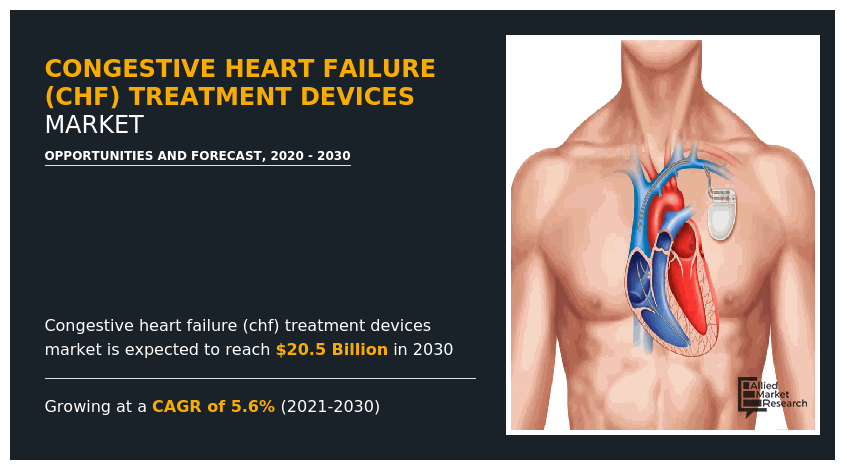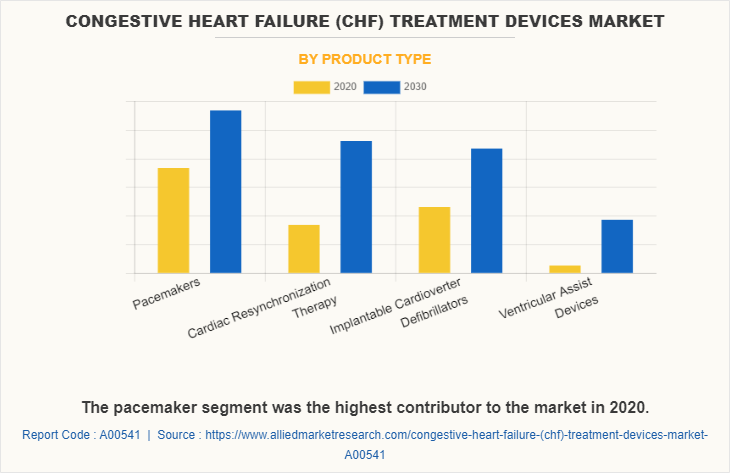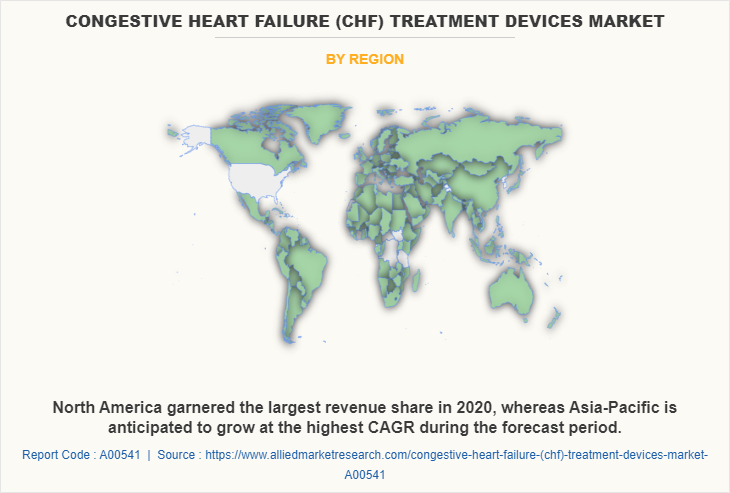Congestive Heart Failure (CHF) Treatment Devices Market Research, 2030
The global congestive heart failure treatment devices market was valued at $11.9 billion in 2020, and is projected to reach $20.5 billion by 2030, growing at a CAGR of 5.6% from 2021 to 2030.
Congestive heart failure treatment device is known as mechanical circulatory support device. There are different types of congestive heart failure treatment devices such as, pacemakers, cardiac resynchronization therapy devices, implantable cardioverter defibrillators, and ventricular assist devices. The implantable cardiac defibrillator is an electronic device that is placed inside the body. An ICD (implantable cardiac defibrillator) constantly keeps track of heart rhythm and sends a small shock to the heart muscle if the rhythm becomes abnormal. A ventricular assist is a device that helps to pump the blood from the lower chambers of heart to the rest of the human body. In addition, there are different types of ventricular assist devices, such as left congestive heart failure treatment devices(LVADs), right congestive heart failure treatment devices(RVADs), and others. Left congestive heart failure treatment devicesare the most widely used VADs, as the prevalence of weak left ventricle muscles is common among the affected patients. They have been used as a permanent solution in patients who have minor chances of improvement of cardiac muscles. Right congestive heart failure treatment devices(RVADs) are used to pump blood to the pulmonary aorta from the right ventricle. Such cases are relatively rare as compared to the cases with need of LVAD.

Growth of the global CHF treatment devices market is majorly driven by rise in prevalence of cardiovascular disorders, increase in risk of organ failure, and development of new congestive heart failure treatment devices by large number of heart failure device companies. According to Organ Procurement and Transplantation Network, 3,582 candidates were registered on the waiting list for heart transplant as of June 2020 in the U.S. Thus, rise in number of patient with heart failure has increased the demand for ventricular assist devices, which is anticipated to foster the growth of the market and provide congestive heart failure treatment devices market opportunity. Furthermore, surge in geriatric population has increased the number of cardiovascular disease cases, and rise in shortage of organ donors are some congestive heart failure treatment devices market trends which further fuel growth of the market. According to World Health Organization, it is estimated that 17.9 million people died from cardiovascular disease in 2019. Thus, upsurge in burden of cardiovascular diseases and increased rate of heart failure are anticipated to boost the growth of the market. Furthermore, rise in number of product approvals is expected to provide remunerative opportunities for the congestive heart failure treatment devices market growth.
The COVID-19 outbreak is anticipated to have a negative impact on the growth of the global congestive heart failure treatment devices market. According to Society of Thoracic Surgeons, there was sharp reduction of adult cardiac surgery volumes during the first wave of the pandemic. The Mid-Atlantic area (New York, New Jersey, and Pennsylvania) was among the hardest hit during the first surge of the COVID pandemic, experiencing a 71% decrease in overall cardiac surgery case volume. In addition, the COVID-19 pandemic has stressed the healthcare system in the world. A huge number of clinics and hospitals across the globe were restructured to increase the hospital capacity for patients diagnosed with COVID-19. This led to cancellation of many non-essential surgical procedures across the world. Moreover, according to American College of Cardiology, surveys were submitted from 909 inpatient and outpatient centers performing cardiac diagnostic procedures in 108 countries. According to researchers, procedure volumes decreased 42% from March 2019 to March 2020, and 64% from March 2019 to April 2020. Thus, decrease in number of cardiac surgeries has led to decline in the usage and production of congestive heart failure treatment devices, which has restricted the growth during congestive heart failure treatment devices market forecast.
In addition,the market is restrained by high cost of the procedure and certain risks associated with the congestive heart failure treatment devices.
Congestive Heart Failure (CHF) Treatment Devices Market Segmentation
The congestive heart failure treatment devices market is segmented on the basis of product and region. On the basis of product, it is divided into pacemakers, cardiac resynchronization therapy (CRT), implantable cardioverter defibrillator (ICDs), and ventricular assist device (VADs).Pacemaker is further bifurcated into implantable pacemaker and external pacemakers. In addition, CRT devices segment is segmented into two major types, namely, CRT-P and CRT-D. Furthermore, ICDs is further segmented into transvenous implantable cardioverter defibrillator (T-ICDs) and subcutaneous implantable cardioverter defibrillator (S-ICDs). Moreover, VADs is also segmented into left ventricular assist device (LVAD), right ventricular assist device (RVAD), and biventricular assist device (BIVAD).
Region-wise, the market is analyzed across North America (the U.S., Canada, and Mexico), Europe (Germany, France, the UK, Italy, Spain, and rest of Europe), Asia-Pacific (Japan, China, Australia, India, South Korea, and rest of Asia-Pacific), and LAMEA (Brazil, Saudi Arabia, South Africa, and rest of LAMEA).
Segment review
Depending on product, the pacemakers segment dominated the congestive heart failure treatment devices market size in 2020, and this trend is expected to continue during the forecast period, owing to increase in R&D activities in the pharmaceutical & medical device industry, rise in demand for congestive heart failure treatment devices for the treatment of heart failure, and surge in adoption of pacemakers. However, the ventricular assist device segment is expected to witness considerable growth during the forecast period, owing to upsurge in number of cardiac surgeries and rise in number of key players for development of congestive heart failure treatment devices in the medical device industry.

North America garnered largest congestive heart failure treatment devices market share in 2020, and is expected to continue to dominate during the forecast period, owing to rise in number of cardiac surgeries, presence of key players, development of the healthcare sector, and presence of new innovative ventricular assist and devices products in the region. However, Asia-Pacific is expected to register the highest CAGR of 6.2% in congestive heart failure treatment devices Market size, owing to surge in use for lifetime support and development of healthcare infrastructure.

Key Benefits For Stakeholders
- This report provides a quantitative analysis of the market segments, current trends, estimations, and dynamics of the congestive heart failure (CHF) treatment devices market analysis from 2020 to 2030 to identify the prevailing congestive heart failure (chf) treatment devices market opportunities.
- The market research is offered along with information related to key drivers, restraints, and opportunities.
- Porter's five forces analysis highlights the potency of buyers and suppliers to enable stakeholders make profit-oriented business decisions and strengthen their supplier-buyer network.
- In-depth analysis of the congestive heart failure (chf) treatment devices market segmentation assists to determine the prevailing market opportunities.
- Major countries in each region are mapped according to their revenue contribution to the global market.
- Market player positioning facilitates benchmarking and provides a clear understanding of the present position of the market players.
- The report includes the analysis of the regional as well as global congestive heart failure (chf) treatment devices market trends, key players, market segments, application areas, and market growth strategies.
Congestive Heart Failure (CHF) Treatment Devices Market Report Highlights
| Aspects | Details |
| By Product Type |
|
| By Region |
|
| Key Market Players | Medtronic Plc, Berlin Heart GmbH, Microport Scientific Corporation, Abiomed Inc., Boston Scientific Corporation, Jarvik Heart Inc, Osypka Medical GmbH, abbot laboratories, Lepu Medical, Biotronik SE and Co. KG |
Analyst Review
The utilization of CHF treatment devices is likelyto witness a significant rise with increased diagnosis of arrhythmias and heart failures. CHF treatment devices market has piqued the interest of healthcare providers due to several benefits offered by these devices to monitor and treat irregular heart rhythm coupled with the evolving indications for CHF treatment devices. There have been remarkable technological advancements in CHF treatment devices to provide advanced treatment options for the management of cardiac rhythm of heart patients. As the market is saturated and is growing at a steady rate in developed nations, Asia-Pacific and LAMEA are expected to offer high growth opportunities to the key players in this market.
Greater consumer awareness &demand for preventive healthcare services, escalating demand for healthcare services from overall population, and new advancements are predicted to broaden congestive heart failure treatment devices clinical applications and increase the number of product approvals. Furthermore, use of congestive heart failure treatment devices for lifetime support contributestoward growth of the market.
The market gains interest of healthcare companies, owing to focus on preventive facilities provided to patients who undergo critical pulmonary surgeries, which are more complex than other health conditions. This leads to increase in utilization of congestive heart failure treatment devices; thus creating a great opportunity to further propel the growth of the market.
North America is expected to witness highest growth, in terms of revenue, owing to rise in geriatric population, presence of key players, and advancements in healthcare investments. However, Asia-Pacific was the third largest contributor to the market in 2020, and is expected to register fastest CAGR during the forecast period, owing to increase in number of cardiovascular surgeries and unmet needs for advanced congestive heart failure treatment devices. However, high cost associated with congestive heart failure treatment devices are expected to restrain the market growth during the forecast period.
The total market value of congestive heart failure treatment devices market is $11,897.97 million in 2020.
The forecast period for congestive heart failure treatment Devices market is 2021 to 2030.
The base year is 2020 in congestive heart failure treatment devices market
Top companies such as Abbot Laboratories (St. Jude Medical Inc.), Abiomed Inc., Berlin Heart GmbH, Biotronik SE & Co. KG, Boston Scientific Corporation, Jarvik Heart Inc, Lepu Medical, Medtronic Plc, Microport Scientific Corporation, and Osypka Medical GmbH held a high market position in 2020.
Pacemakers segment dominated the global market in 2020, and expected to continue this trend throughout the forecast period due to the technological advancements and new product launch and thus is expected to drive the segment
Increase in demand for new technologies in congestive heart failure treatment devices, advanced infrastructure for research & development and investments in healthcare is anticipated to drive the market in the forecast period.
Loading Table Of Content...



